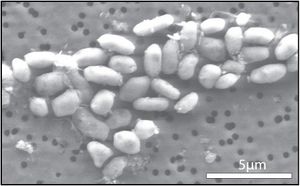Gfaj-1 NEUF2011
A Microbial Biorealm page on the genus Gfaj-1 NEUF2011

Classification
Higher order taxa
Domain; Phylum; Class; Order; family [Others may be used. Use NCBI link to find]
Domain: Bacteria
Phylum: Proteobacteria
Class: Gammaproteobacteria
Order: Oceanospirillales
Family: Halomonadaceae
Species: GFAJ-1
Species
|
NCBI: Taxonomy |
GFAJ-1 is actually not a new species but is considered a new strain of the family Halomonadaceae.
Description and significance
GFAJ-1 uses arsenic in place of phosphorus to support life. GFA-1 is a known strain of the Gammaproteobacteria class. Arsenic in its arsenate form is often toxic to cells due to its similarities to phosphate. GFAJ-1 is challenging the accepted hypotheses that life can only be sustained with the minimum essential elements: Hydrogen, Carbon, Oxygen, Nitrogen, Sulfur, and Phosphorus. In a phosphorus-deprived environment, NASA researchers have found that GFAJ-1 was able to grow and reproduce using and incorporating arsenic into cell mass in place of Phosphorus. Researchers have suggested that this strain of bacteria have a type of arsenic adaptation that will allow the organism to survive with low levels of phosphorus. The mechanism for this pathway is still unknown and there is ongoing research to learn more about the bacteria. The discovery of a potential to sustain life by substituting arsenic for phosphorus could lead to many more research projects and change the guidelines for minimal environments capable of sustaining life. References: http://www.nasa.gov/topics/universe/features/astrobiology_toxic_chemical.html
http://www.sciencemag.org/content/early/2010/12/01/science.1197258.full.pdf
Genome structure
The Genome of GFAJ-1 has not yet but fully investigated. There has been claims that this organism incorporates arsenic into its DNA in place of phosphate however this has not yet but confirmed. This would involve the addition of dAMA, dTMA, dGMA, and dCMA which are structural analogs of dAMP etc.
Cell structure and metabolism
GFAJ-1 is rod-shaped (bacillus) bacterium known to be an extremophile or more appropriately, a halophile meaning it is capable of living in environments with extremely high salt concentrations that would kill most other bacteria. GFAJ-1 like other halophiles, is able to produce osmoprotectants which build up in the organism’s cytoplasm along with other ions to deal with the hypotonic environment and ultimately protect against high salt levels [4]. Living in a high salt environment means water will inherently want to move down the concentration gradient and travel out of the cell into the outside environment, so any halophilic organism must deal with this problem.
Not much is known about the cell structure of GFAJ-1, but the first study on the organism by Wolfe-Simon et al. reveals large vacuole-like structures that appear to increase in size upon the addition of Arsenic into the organism’s environment [2]. These vacuoles may be crucial in GFAJ-1’s survival in an arsenic rich habitat but more research needs to be completed in order to further understand this concept.
Ecology
The recently discovered GFAJ-1 bacterium, isolated from Mono Lake in California, has provided researchers substantial information pertaining to the growth of organisms in extremely harsh environments in which life was thought to be nearly non-existent. Mono Lake has quite abnormal qualities in that it is hypersaline and a highly alkaline body of water. The salt content of the lake had been measured to be approximately 90 grams/liter and the pH to be around 9.8 [1]. But most interesting of all is Mono Lake’s highest natural concentrations of arsenic in the world with a concentration of roughly 200μM. These high levels are thought to occur because the arid environment has significant evaporation over precipitation and the abundance of hot-springs in the area [2].
It had been found that many bacteria are known to be able to withstand high levels of arsenic and have the molecular adaptations in order to so. However, when starved for essential nutrients, in particular phosphorus, the GFAJ-1 bacterium will actually incorporate arsenic from the water into its molecular machinery, replacing phosphorus, to continue living and growing [3].
Because so little is known about this recently discovered bacterium, it still very much unclear as to how it actually survives by replacing phosphorus with arsenic. The original study of the GFAJ-1 bacterium exhibited arsenic-dependent growth through means of AsO43- uptake and assimilation into key biomolecules that include nucleic acids, proteins, and metabolites. However, when provided with phosphorus, GFAJ-1 grew significantly better indicating that the bacterium is not purely an arsenophile [2].
The contributions made by this arsenophile to the environment is also unclear, however it is thought to be linked to an environmental flow of energy particularly the mobilization of solid phase arsenic found in minerals to an aqueous phase. It is speculated that the arsenic cycling nature of the bacterium negatively contributes to the contamination of drinking water of nearby wells [2].
Pathology
How does this organism cause disease? Human, animal, plant hosts? Virulence factors, as well as patient symptoms.
Current Research
Enter summaries of the most recent research here--at least three required
Cool Factor
GFAJ is an acronym for "Give Felisa a Job," Felisa being the author of the first paper on GFAJ-1.
References
1. Oremland, R., and J. Stolz. "The Ecology of Arsenic." Science 300 (2003): 939-944.
2. Wolfe-Simon, Felisa, Jodi Blum, Thomas Kulp, et.al. "A Bacterium That Can Grow by Using Arsenic Instead of Phosphorus." Science 332 (2011): 1163-1166.
3. Bortman, Henry. "Thriving on Arsenic." Astrobiology Magazine -- The Origin and Evolution of Life in the Universe. NASA, 2 Dec. 2010.
4. Santos, H and M. S Da Costa. 2002. Compatible solutes of organisms that live in hot saline environments. Environmental Microbiology 4: 501-509
5. Oremland, Ronald, John Stolz, and James Hollibaugh. "The Microbial Arsenic Cycle in Mono Lake, California." FEMS Microbiology Ecology 48 (2004): 15-27
Edited by Robert Murphy, Sarah Peterson, Daniel Wiegand, and Brian Collette (students of Iris Keren)

